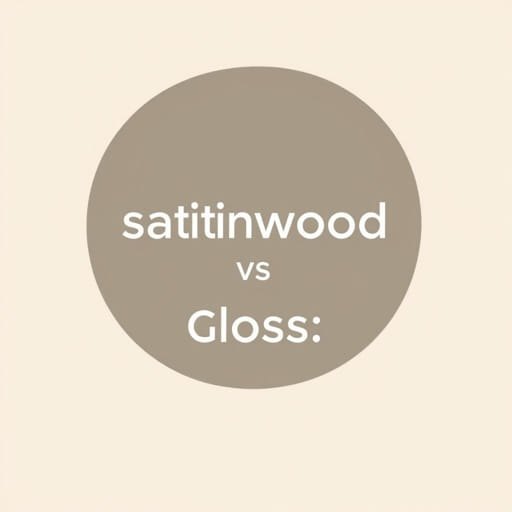When choosing the right paint finish for your walls, trim, or furniture, the decision between satinwood and gloss can be surprisingly important. Each finish offers different characteristics, not just in terms of appearance but also in durability, maintenance, and how it complements your overall interior or exterior design. Many homeowners and decorators often ask, Is satinwood better than gloss? The answer isn’t simple it depends on what you need the finish to do, where it will be applied, and the overall style you’re aiming for. Understanding both options will help you make a more informed decision that adds value and beauty to your home.
Understanding Satinwood Finish
What Is Satinwood?
Satinwood is a paint finish that falls between eggshell and semi-gloss on the sheen spectrum. It offers a soft, subtle shine without the high reflective quality of gloss. Satinwood is often used in both modern and traditional interiors because of its versatility. It’s not completely matte, but it’s far from shiny, making it ideal for people who want a hint of sheen without an overpowering glare.
Benefits of Satinwood
- Subtle elegance: Satinwood provides a refined look that works well in living rooms, bedrooms, and kitchens.
- Durability: Though not as tough as gloss, satinwood is still strong enough to withstand light wear and tear.
- Easy to maintain: It resists dirt and is fairly easy to clean with a damp cloth.
- Better for uneven surfaces: Because it’s less reflective, satinwood hides surface imperfections more effectively than gloss.
Understanding Gloss Finish
What Is Gloss Paint?
Gloss paint is the shiniest of all finishes and reflects the most light. It’s highly durable, moisture-resistant, and commonly used in areas where high traffic and exposure to water or dirt are concerns. Gloss is the go-to for trim, skirting boards, doors, and even kitchen cabinets due to its resistance to stains and ease of cleaning.
Benefits of Gloss
- Maximum durability: Gloss finishes are tough and long-lasting, making them ideal for high-use surfaces.
- High sheen: If you want a polished, luxurious, or modern look, gloss provides a bold aesthetic.
- Moisture resistance: Perfect for bathrooms, kitchens, and other damp environments.
- Easy cleaning: Gloss surfaces can be wiped clean easily, making maintenance quick and simple.
Comparing Satinwood and Gloss
Appearance and Style
The look you want to achieve plays a big role in choosing between satinwood and gloss. Satinwood is preferred when a more muted, elegant finish is desired. It works well in classic, rustic, or contemporary interiors where a high-shine might seem out of place. Gloss, on the other hand, is excellent for creating contrast or accentuating features like moldings and frames. Its shiny nature makes colors look more vibrant and bold.
Surface Preparation
Gloss requires more precise surface preparation. Because of its reflective quality, gloss paint will magnify any dents, scratches, or uneven textures. Satinwood is more forgiving and can be applied with less surface perfection, which makes it a better choice for older walls or furniture that have imperfections.
Durability and Resistance
Gloss outperforms satinwood when it comes to sheer durability. It handles scrubbing, cleaning, and moisture better, which makes it ideal for kitchens, bathrooms, or high-touch areas. Satinwood is still relatively durable but may not hold up as well in extremely wet or high-traffic areas.
Application and Touch-Ups
Satinwood tends to be easier to apply evenly, especially for beginners. It also touches up more seamlessly. Gloss can be tricky because any brush marks or inconsistencies in thickness can be very noticeable once it dries. If you’re doing a DIY paint job and want fewer complications, satinwood may be the better choice.
Where to Use Satinwood and Gloss
Best Areas for Satinwood
- Interior walls in living rooms, dining rooms, and bedrooms
- Furniture with decorative detailing
- Woodwork and trim in areas with moderate wear
Best Areas for Gloss
- Skirting boards and door frames
- Cabinets in bathrooms and kitchens
- Outdoor woodwork like doors and windows
Maintenance and Cleaning
Gloss finishes are incredibly easy to clean. Their smooth, shiny surfaces repel dust and grime, and most messes can be wiped away with minimal effort. Satinwood also resists stains but may require gentler cleaning techniques to avoid dulling its subtle sheen. If maintenance is your top priority, gloss offers a slight edge.
Environmental and Health Considerations
Both satinwood and gloss are available in oil-based and water-based formulas. Oil-based paints tend to have stronger fumes and longer drying times, especially in gloss finishes. Water-based options are more eco-friendly and emit fewer VOCs (volatile organic compounds), making them better for indoor air quality. If health and environmental factors matter to you, look for low-VOC or water-based formulas regardless of the finish.
Cost Differences
There’s not usually a significant price difference between satinwood and gloss paints from the same brand, but gloss can sometimes cost slightly more due to its longer-lasting performance. Keep in mind, however, that the quality of the product matters more than the finish type alone. A high-quality satinwood can outperform a low-grade gloss in many situations.
Which One Is Better?
So, is satinwood better than gloss? The answer depends on your priorities. If you’re aiming for durability, shine, and easy cleaning, gloss may be the better choice, especially in high-use or wet areas. But if you want a more subtle look, easier application, and a finish that complements a wide range of interior styles, satinwood is often the winner. Both finishes have their strengths and can serve different purposes throughout your home. In many cases, a combination of satinwood and gloss may deliver the best results, giving you both functionality and style where you need them most.
